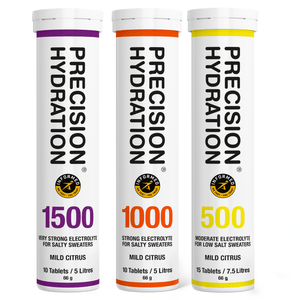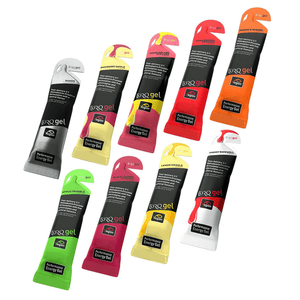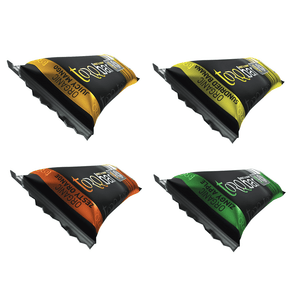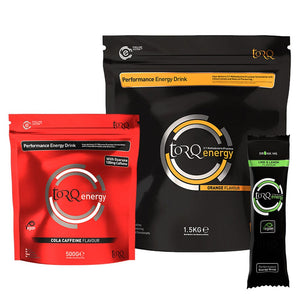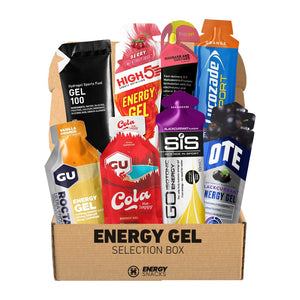It’s your choice - with our knowledge.

Here's What You Need to Know About Energy Gels for Running
Energy gels are one of the most convenient and effective ways for runners to fuel on the go, perfect for any distance from 10k to Ultra Marathon.
Energy gels contain carbs that are easily digested and absorbed, often from multiple sources, to give runners an energy boost during training and races.
Fuel for Endurance
Running can be incredibly physically demanding and requires a lot of energy. For this reason, it’s important for runners to keep fuelling throughout training sessions and races to sustain energy levels.
Gels provide a convenient lightweight solution to fuelling and are particularly useful when running longer distances as they take up less space than other fuel sources like energy bars.
Nutritional Breakdown
Every energy gel is different however most share some common ingredients.
Carbohydrates:
Carbs are the body’s primary source of energy, typically energy gels contain somewhere between 20-40g of Carbohydrates (although some high-carb gels may contain more). These can be from a single source such as Maltodextrin, or from multiple sources- for example a Maltodextrin & Fructose blend.
Dual source carbs are becoming increasingly popular in energy gels as they can be absorbed quicker.
Electrolytes:
Electrolytes are crucial for maintaining proper hydration. Drinking water is also key, but drink too much water and you risk diluting your blood sodium (electrolyte) levels and becoming extremely dehydrated.
Electrolytes commonly found in energy gels include Sodium, Magnesium, Potassium and Chloride (quantities vary).
Caffeine:
Caffeine is a stimulant rather than energy source, however some runners find it very helpful for improving focus especially towards the end of a long race.
Typically, caffeinated energy gels contain around 100mg Caffeine, but this can vary from brand to brand.
BCAAs:
Branch Chain Amino-Acids, or BCAAs, are included in some gels as they can help to reduce muscle fatigue and damage, in turn aiding recovery.
Timing and Consumption
Quantities and timings will depend on the length of event and your personal nutritional requirements however there are some general guidelines that all runners can follow.
Pre-run:
Take an energy gel around 15-30 minutes before your workout for a fast-acting source of fuel. This will top up your glycogen stores providing an initial boost of energy.
During:
During longer training sessions and races, many runners rely on energy gels for their on-the-go fuel. Gels are ideal for exercise lasting 60 minutes and over. Typically runners need between 60-90g carbs per hour so you should consume a gel around every 30-45 minutes.
Make sure to check the instructions for your gels as some are designed to be taken and more regular or less frequent intervals.
Note: You should only consume one energy gel at a time. Taking two won’t give you double the energy and is more likely to lead to an energy crash as your body tries to process the sugar content.
Hydration:
Although energy gels will provide you with a steady source of energy, you shouldn’t ignore your hydration. Even if your gels contain electrolytes, you will still need to take on fluids (water) during your run.
Some gels are designed to be taken with water to ease digestion, so again check the instructions for your chosen gels.
Popular at XMiles
The following are some of our most popular product ranges designed to help runners build a perfect fuelling system.
Precision Fuel & Hydration:
The PF 30 Gel from Precision Fuel & Hydration is one of our most popular energy gels with runners. Made with athletes in mind, these gels provide a quick and efficient way to refuel on the go, delivering 30g carbs per gel.
As a runner you should aim to consume around 60-90g Carbs per hour during activity lasting longer than 60 minutes. The PF 30 Gel is perfect for activities lasting over 60 minutes and can be paired with other products in the Precision Fuel & Hydration range to craft your perfect nutrition plan.
Try with:
TORQ:
The TORQ Energy Gel utilises a blend of maltodextrin and fructose to deliver 30g carbs in one small packet. Designed to function as part of the TORQ Fuelling System, these gels can be combined with other products in the TORQ range for optimal fuelling.
Try with:
According to the TORQ Fuelling System, runners should aim to consume 2-3 ‘TORQ Units’ per hour.
1 TORQ unit= 30g Carbs, therefore if you’re fuelling with just gels you should aim to consume 2-3 of these per hour.
Note: If choosing to rely on gels for your energy needs, don’t forget about your hydration.
GU Energy:
Producing the world’s first energy gel in 1991, GU have continued to grow their product range and remain popular ever since. The GU Energy Gel is the perfect compact energy source, favoured by runners all over the world.
With carbs for energy, electrolytes for hydration, and BCAAs to protect muscles, the GU gel has a lot to offer.
If traditional syrupy gels aren’t your thing, then not to worry GU have you covered with their Liquid Energy Gel. This gel has all the benefits of the original gel but in a light and smooth liquid form.
Personalization and Experimentation
The best way to find out which energy gels are right for you is experimentation. By trying as many gels and fuelling strategies as possible during your training, you will be able to personalise your perfect nutrition plan and avoid any bad reactions on race day.
Try to keep a training log and track the different gels you’ve tried, making a note of the effects of each gel. This will help you to compare different products and decide based on the results.
You may also like to use multiple different gels during a run, also keep note of how these interact with each other.
If you’re not sure where to start then our Energy Gel Selection Box is a great way to try out new products, with the contents updated every month you might just find your perfect gel.
Takeaway
To use energy gels effectively and see the best results, always make sure to follow the product instructions, consume at the appropriate intervals, and never take more than 1 gel at a time.
It’s also important not to skip proper nutrition and hydration. Gels are a great source of energy during a race or training sessions but are not a substitute for proper nutrition and hydration, which are both crucial for achieving optimal performance.
Related articles
It’s your choice - with our knowledge.











































































































